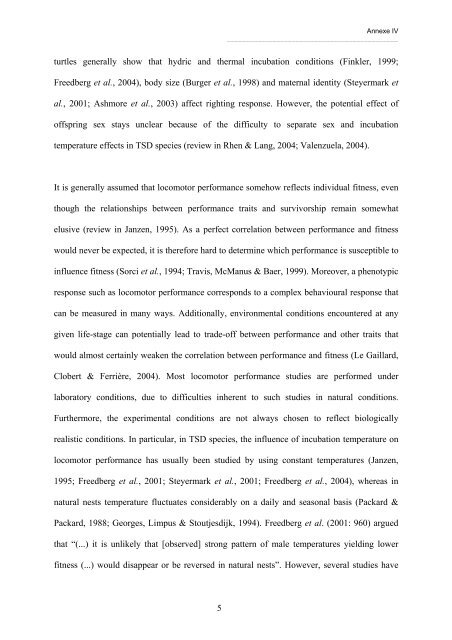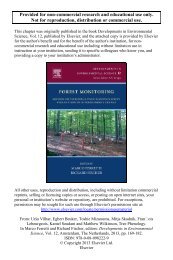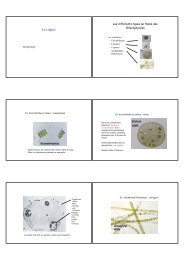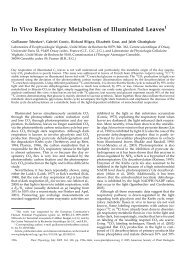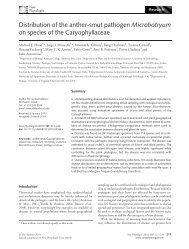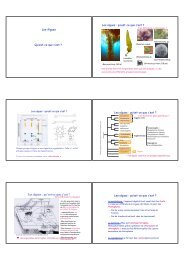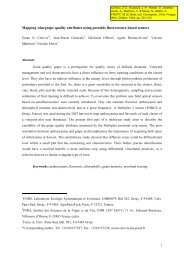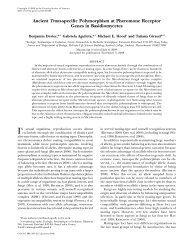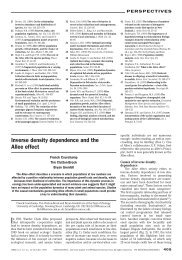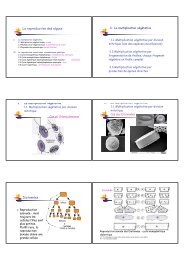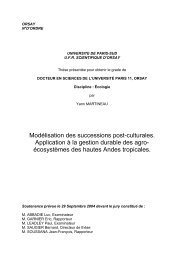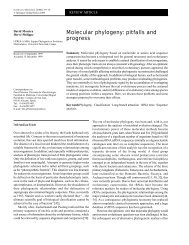Premiers - Outil de Suivi des Contrats
Premiers - Outil de Suivi des Contrats
Premiers - Outil de Suivi des Contrats
Create successful ePaper yourself
Turn your PDF publications into a flip-book with our unique Google optimized e-Paper software.
Annexe IV<br />
_____________________________________________<br />
turtles generally show that hydric and thermal incubation conditions (Finkler, 1999;<br />
Freedberg et al., 2004), body size (Burger et al., 1998) and maternal i<strong>de</strong>ntity (Steyermark et<br />
al., 2001; Ashmore et al., 2003) affect righting response. However, the potential effect of<br />
offspring sex stays unclear because of the difficulty to separate sex and incubation<br />
temperature effects in TSD species (review in Rhen & Lang, 2004; Valenzuela, 2004).<br />
It is generally assumed that locomotor performance somehow reflects individual fitness, even<br />
though the relationships between performance traits and survivorship remain somewhat<br />
elusive (review in Janzen, 1995). As a perfect correlation between performance and fitness<br />
would never be expected, it is therefore hard to <strong>de</strong>termine which performance is susceptible to<br />
influence fitness (Sorci et al., 1994; Travis, McManus & Baer, 1999). Moreover, a phenotypic<br />
response such as locomotor performance corresponds to a complex behavioural response that<br />
can be measured in many ways. Additionally, environmental conditions encountered at any<br />
given life-stage can potentially lead to tra<strong>de</strong>-off between performance and other traits that<br />
would almost certainly weaken the correlation between performance and fitness (Le Gaillard,<br />
Clobert & Ferrière, 2004). Most locomotor performance studies are performed un<strong>de</strong>r<br />
laboratory conditions, due to difficulties inherent to such studies in natural conditions.<br />
Furthermore, the experimental conditions are not always chosen to reflect biologically<br />
realistic conditions. In particular, in TSD species, the influence of incubation temperature on<br />
locomotor performance has usually been studied by using constant temperatures (Janzen,<br />
1995; Freedberg et al., 2001; Steyermark et al., 2001; Freedberg et al., 2004), whereas in<br />
natural nests temperature fluctuates consi<strong>de</strong>rably on a daily and seasonal basis (Packard &<br />
Packard, 1988; Georges, Limpus & Stoutjesdijk, 1994). Freedberg et al. (2001: 960) argued<br />
that “(...) it is unlikely that [observed] strong pattern of male temperatures yielding lower<br />
fitness (...) would disappear or be reversed in natural nests”. However, several studies have<br />
5


